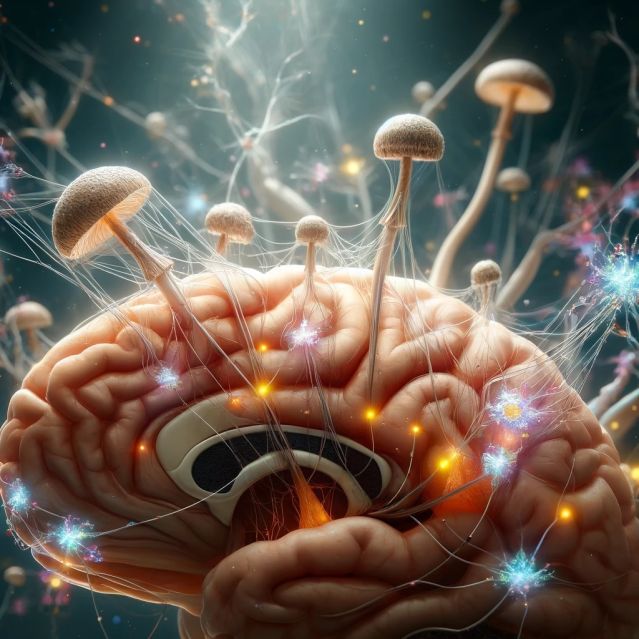Psychedelics
The Stoned Ape Theory Revisited
The role of psychedelics in the evolution of consciousness.
Updated June 1, 2024 Reviewed by Kaja Perina
Key points
- The ritualistic use of psychedelic in indigenous cultures may enhance the evolution of human consciousness.
- Psychedelics are psychoplastogens - they stimulate neuroplastic changes in the brains of those who use them.
- Psychedelics enhance cognition, stimulate creativity, and trigger mystical states of consciousness.
Co-written with Clark Maxon.
A theory proposed in 1992 by American ethnobotanist Terence McKenna in his book Food of the Gods is often informally referred to as the “Stoned Ape” theory. McKenna proposed that the evolution from Homo erectus to Homo sapiens and the cognitive enhancement associated with this change was the result of ingesting psilocybin mushrooms starting about 100,000 years ago.
McKenna suggested psilocybin mushrooms were an "evolutionary catalyst" that triggered language, imagination, the arts, religion, philosophy, science, and other components of human culture. He proposed that different doses of psilocybin produce different effects including enhanced sensory perception, improved cognitive functioning, and increased activity in the “language-forming region of the brain.”
How was the Stoned Ape Theory Received?
McKenna’s theory was widely criticized by the mainstream scientific community who argued that the theory was overly speculative. Critics claimed that various indigenous populations, such as Amazonian cultures who use psychedelic substances, do not exhibit any of the evolutionary advantages that McKenna argued would emerge from using psilocybin-containing substances. But, how do advances in anthropology, neuroscience, and pharmacology inform the debate?
Evidence Supporting this Theory
Since McKenna proposed his theory 32 years ago, an abundance of research has examined the effects of psychedelics on the brain and on consciousness. These studies have identified changes at chemical, physiological, neuroanatomical, neuropsychological, and spiritual levels.
For example, psychedelic medicines have been found to enhance neuropsychological functioning. Dr. Charles Grob at the University of California, Los Angeles and colleagues conducted a study in the early 1990's exploring the effects of regular ayahuasca use in Brazil. They found that individuals who drank ayahuasca regularly scored higher on neuropsychological tests than controls who did not drink this brew.
Dr. Jose Carlos Bouso and colleagues from Brazil similarly found improved neuropsychological functioning in regular ayahuasca users. Dr. Rafael dos Santos from Brazil conducted a review of 28 articles and found ayahuasca use was associated with increased cortical thickness of the anterior cingulate cortex. Additional studies have demonstrated that psychedelics exhibit pro-cognitive effects.
Additionally, since the publication of Food of the Gods, the fields of biological and cultural anthropology have advanced the understanding of the ways in which genetic changes and human culture have interacted throughout human evolution. Indeed, some have suggested that culture drives human evolution to a greater extent than genetic changes. The use of psychedelics in indigenous cultures, controlled through prescribed set and setting, is a cultural near-universal that suggests an evolutionary heritage.
The use of psychedelics may have led to a unique approach to survival in humans, an approach that depends on higher levels of consciousness. The controlled use of psychedelics promotes mindfulness and decentering, the ability to step back from overidentification with thoughts and feelings as an observer. Mindfulness and decentering increase levels of self-awareness, allowing for more complex and nuanced social interactions and cultural transmission. Many therapeutic modalities (Cognitive Behavioral Therapy, Dialectical Behavioral Therapy, Internal Family Systems Therapy, and Narrative Therapy) involve mindfulness and decentering. Similarly, the development of transcendent awareness, understanding one’s role in something “greater”, promotes an adaptive connection to the environment and connection to ancestral lineage. Transcendent awareness in human societies promotes a more nuanced approach to living in synergistic harmony with the environment. Higher levels of consciousness facilitate the ability to access creative and intuitive problem solving methods.
How do psychedelics accomplish this? Two potential mechanisms involve changes in consciousness and enhanced neuroplasticity.
Psychedelics and changes in consciousness
Psychedelics have been demonstrated to change the consciousness of those who ingest them. When used in a controlled manner, these changes include improved processing speed, improved memory, enhanced creativity, and improved problem solving. In addition, psychedelic medicines can change one’s perspective, producing a persistent change in one’s world view.
Psychedelics as psychoplastogens
David Olsen at UC Davis has coined the term “psychoplastogens” to refer to medicines that rapidly produce changes in neuroplasticity following a single therapeutic administration. Medicines that meet these criteria include ketamine, N,N-dimethyltryptamine or DMT (which is one of the active ingredients in ayahuasca), lysergic acid diethylamide (LSD), 3,4-methylenedioxymethamphetamine (MDMA), ibogaine, and psilocybin.

Psychoplastogens can stimulate numerous types of neuroplastic changes including
- Neurogenesis - the growth of new neurons
- Synaptogenesis - the production of new synapses or connections between neurons
- Re-myelination of neurons - replacing lost myelin or insulation on neurons
- Activation of silent synapses - turning dormant synapses into active synapses
What are the potential implications of the neuroplastic changes associated with psychedelics?
The therapeutic ingestion of psychedelics over time produces neuroplastic changes that may lead to ongoing alterations in consciousness. These changes may include the experience of mystical states of consciousness, or what psychiatrist Maurice Bucke called “Cosmic Consciousness.” Bucke described this as a “higher form of consciousness” which includes a consciousness of the life and order of the universe, an intellectual enlightenment or illumination, a feeling of joyousness, and an awareness of consciousness existing beyond this life. These experiences are also described by individuals who undergo a near-death experience, a mystical experience, or astronauts who experience the overview effect.
Additional adaptive characteristics of this type of consciousness may include time travel, enhanced intuition, the ability to communicate with plants and animals, increased awareness of energy, increased humility and decreased hubris, increased interest in community relationships, decreased interest in material possessions, and an increased concern about the exploitation of natural resources.
Conclusions
The idea that indigenous cultures who utilize psychedelics are “less evolved” belies an ethnocentric view resulting from cultural prejudice. In fact, a deeper investigation into the worldview of many indigenous cultures highlights a more enlightened perspective that includes a deeper understanding of our connection with the natural world, an enhanced awareness of energy, humility, and a strong sense of our place in this world.
Our judgments about whether a culture is more or less evolved than our own may depend upon whether we value unrestrained growth or a sustainable lifestyle, technological advancement or intuitive wisdom, material wealth or spiritual insight, unlimited cravings or satisfaction with enough. Thus, it appears that the Stoned Ape Theory has strong evidentiary support, for those who are open to exploring it.

Clark Maxon, MA, LPCC, NCC is a therapist at Mayfield Counseling Centers in Colorado Springs. Prior to this position, he served as the founding program coordinator for the Family Resource Center in Academy District 20 to provide no-cost mental health counseling for students. He has also provided consulting services for other local school districts to develop mental health counseling services for students.
References
Barrett, Frederick S., and Roland R. Griffiths. "Classic hallucinogens and mystical experiences: phenomenology and neural correlates." Behavioral neurobiology of psychedelic drugs (2018): 393-430.
Grob, Charles S., Dennis J. McKenna, James C. Callaway, Glacus S. Brito, Edison S. Neves, Guilherme Oberlaender, Oswaldo L. Saide et al. "Human psychopharmacology of hoasca, a plant hallucinogen used in ritual context in Brazil." The Journal of nervous and mental disease 184, no. 2 (1996): 86-94.
Zhou, Yanling, Chengyu Wang, Xiaofeng Lan, Wei Zheng, Hanqiu Li, Ziyuan Chao, Kai Wu, Roger S. McIntyre, and Yuping Ning. "The potential pro-cognitive effects with intravenous subanesthetic ketamine in adults with treatment-resistant major depressive or bipolar disorders and suicidality." Journal of Psychiatric Research 144 (2021): 312-319.
Holas, Paweł, and Justyna Kamińska. "Mindfulness meditation and psychedelics: potential synergies and commonalities." Pharmacological Reports 75, no. 6 (2023): 1398-1409.
Olson, David E. "Psychoplastogens: a promising class of plasticity-promoting neurotherapeutics." Journal of experimental neuroscience 12 (2018): 1179069518800508.




